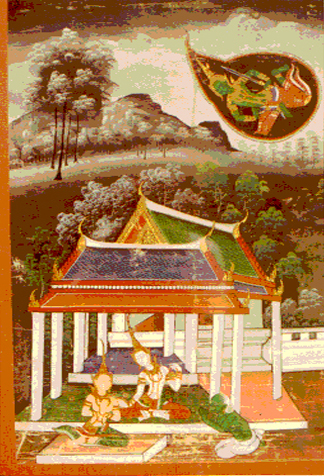Vessantara Jataka, Chapter 10: Indra, in the Form of a Brahmin, Requests Maddi from Vessantara
(Southeast Asia )
An illustration from the Jataka story of Prince Vessantara. The painting is believed to be from the early part of the reign of Rama V (1868-1910). This Jataka tells of the Prince's selfless generosity. In this painting Sakka appears overhead while simultaneously appearing to the Prince as Jujok, a Brahmin, to ask for his wife as a slave. The Prince consents, and as a reward for such generosity, Sakka grants him eight wishes.
The scene takes place in front of two salas (pavilions) which emulate Thai temple architecture. The background setting: the muted black and gray impressionistic landscape indicates the Chinese influence on painting at that time and contrasts with the bright polychrome foreground. The figures of Prince Vessantara and Princess Matsi are dressed and crowned in royal attire, typical of depictions of Rattankosin and earlier periods of Thai art. The Sakka (and his alter self - the Brahmin), as customary, are depicted in green.
Provenance
Provenance (from the French provenir, 'to come from/forth') is the chronology of the ownership, custody, or location of a historical object. Learn more about provenance at the Walters.
Collection of James E. Bogle, Philadelphia, Pennsylvania, 1958, by purchase [in Bangkok, Thailand from Peng Seng, an antique dealer]; Walters Art Museum, 2010, by gift.
Exhibitions
| 1971 | Art of Thailand. Ithaca College Museum of Art, Ithaca. |
| 1981-2002 | Exhibition of Thai Paintings from James Bogle's Collection. Lycoming College Gallery, Williamsport. |
Geographies
Thailand (Place of Origin)
Measurements
H: 34 5/8 x W: 25 3/16 in. (88 x 64 cm)
Credit Line
Gift of Mr. James E. Bogle, 2010
Location in Museum
Not on view
Accession Number
In libraries, galleries, museums, and archives, an accession number is a unique identifier assigned to each object in the collection.
In libraries, galleries, museums, and archives, an accession number is a unique identifier assigned to each object in the collection.
2010.12.2


